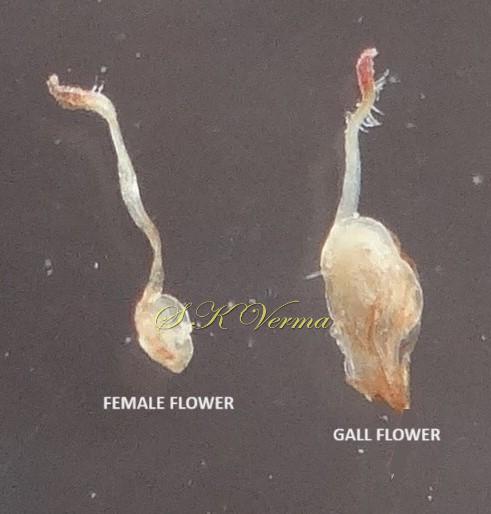FICUS
Ficus
Tourn. ex L., Sp. Pl. 2: 1059. 1753; Corner, Gard. Bull. Singapore 21(1): 1-185. 1965; Corner in Dass. & Fosb., Rev. Handb. Fl. Ceylon 3: 217. fig. 2. 1980; Collett, Fl. Siml. ed. 2: 457. 1921 (Reprint 1980); Parker, For. Fl. Punj. ed. 1: 475. 1918 (Reprint 1973); Fl. China @ eFloras.org 5: 37; Ghafoor, Fl. Pak. @ eFloras.org p. 2.
Trees, shrubs, climbers, stranglers or sometimes woody epiphytes, evergreen or deciduous, with latex, monoecious or functionally dioecious; often with adventitious roots: aerial roots, sometimes as prop roots or climbing roots. Stipules often connate, lateral to amplexicaul and enclosing terminal bud, caducous or +/- persistent, stipule scar ring-like. Leaves simple, alternate or rarely opposite or whorled; entire, serrate or palmately lobed, veins pinnate to +/- palmate; apex obtuse, acute or acuminate; deciduous or persistent. Inflorescences axillary or on specialised cauliflorus branches, hypanthodium (also termed fig) with many minute unisexual flowers inserted on inner wall of hollow receptacle communicating with outside through an apical pore (ostiole) closed by scale-like apical bracts. sessile or pedunculate subtended by usually 3 involucral bracts at base (sometimes present on side of hypanthodium, scale like), caducous or persistent. Flowers of 4 types: Male flowers, Female flowers, Gall flowers and Neuter flowers; sessile or pedicellate, bracteate. Male Flowers: Usually ostiolar in one or more whorls or dispersed. Calyx 2-6 partite or lobed, imbricate. Stamens 1-3(-6), straight in bud; pistillode present or not. Female Flowers: Often numerous, usually away from ostiole, dispersed. Calyx 0-6. Ovary free, straight or oblique, unilocular with single solitary ovule; style eccentric or subapical; stigma simple or bifid. Gall flowers: Abundant and dispersed, usually pedicellate, each with sterile ovary enclosing one developing insect, style usually short. Calyx mostly as in female flowers. Neuter flowers: A few or absent with calyx only. Fruits the enlarged receptacle, termed as fig, syconium or syconus, the inner wall of which is studded with 1-seeded achenes or drupelets (in fertilised fruit); ripe or mature figs are fleshy, smooth or ribbed, with or without sclerotic cells, sometimes splitting orificially. Seeds often compressed with membranous coat and incurved embryo.
884 species
Ficus auriculata
Ficus auriculata
Lour., Fl. Cochinch. 666. 1790; Corner, Gard. Bull. 21(1): 82. 1965; Nair, Fl. Bashahr Himal. 258. 1977; Kaur & Sharma, Fl. Sirmaur 588. 2004; Singh & Sharma, Fl. Chamba Dist. 651. 2006; Fl. China @ eFloras.org 5: 48; Ghafoor, Fl. Pak. @ eFloras.org p. 13; F. roxburghii Wall. ex Miq., Ann. Mus. Lugd.- Bot. 3: 296. 1867; King in Hook. f., Fl. Brit. Ind. 5: 534. 1890; Collett, Fl. Siml. ed. 2: 461. 1921 (Reprint 1980); Parker, For. Fl. Punj. ed. 1: 480. 1918 (Reprint 1973).
A large shrub or small evergreen tree with wide spreading crown, dioecious (studied plants are female). Trunk short, stout, bark yellowish grey, nearly smooth; branches reddish brown, young twigs pubescent, hollow. Leaves alternate; petiole 3-24 cm long, pubescent; leaf blade 12-38 cm x 10-30 cm, stiff coriaceous, broadly ovate or orbicular, usually acute, obtuse or mucronate, entire or toothed, base cordate, 5-7-nerved, 3-4 lateral nerves on each side of midvein, abaxially prominent, lateral nerves joined by almost straight parallel transverse veins; adaxially glabrous, abaxially pubescent especially on veins. Stipules paired, 1.5-2.5 cm long, ovate-lanceolate, pubescent. Hypanthodia in clusters on short thick, leafless branches on the main stem, often near the ground or on larger branches, up to 5 cm across and 4 cm long on 2-4.5 cm long pubescent peduncle; hypanthodia broadly top-shaped, apex depressed, umbilicus large, apical orifice with 5-6 triangular bracts, purple-orange when ripe, longitudinally 8-12-ribbed, silky pubescent; subtended by 3 large unequal ovate or triangular basal bracts, 8-9 mm x 13-17 mm. Female flowers: Subsessile to pedicellate. Sepals united, 2-3 lobed, ovary with subterminal long hairy style, stigma dilated, cylindric. Gall flowers in the lower part of hypanthodia, like female flowers but style short and hairless or with few hairs.
Male flowers not studied.
Common Names: : Elephant Ear Fig, Roxburgh Fig; Fagoora, Phagoora, Tiamble, Timla, Tirmal (Hindi)
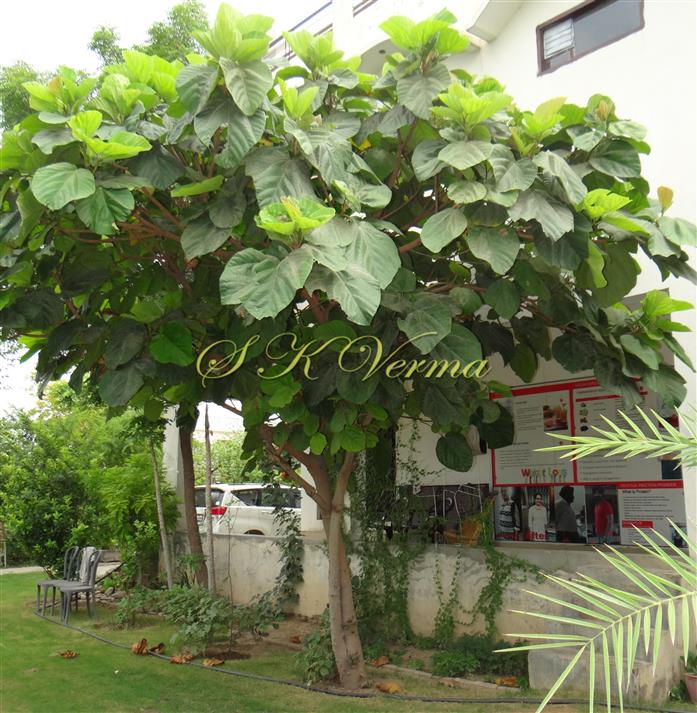
-DSC06421.jpg)
 and Hypanthodia-DSC06419.jpg)
-DSC06568.jpg)
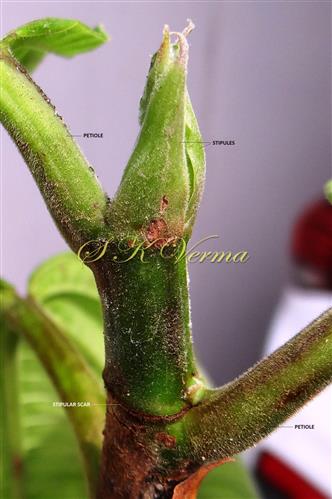
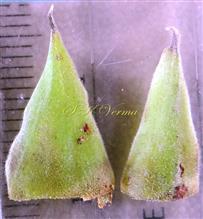
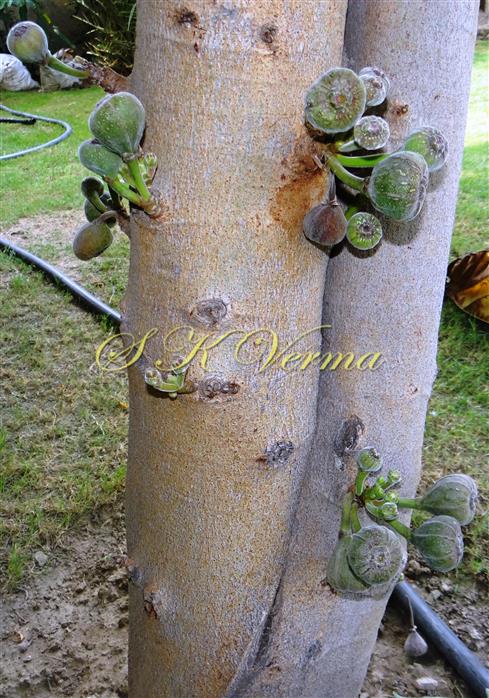
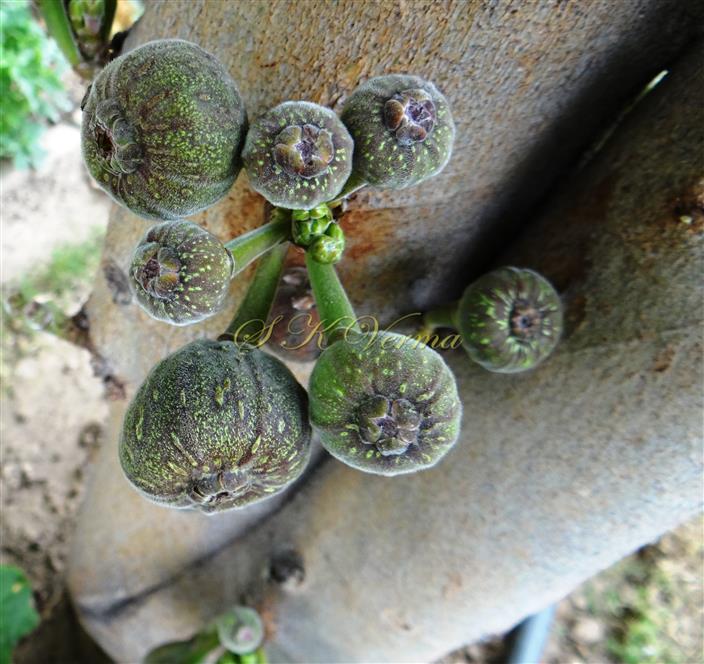
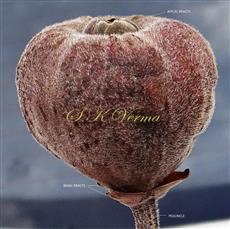
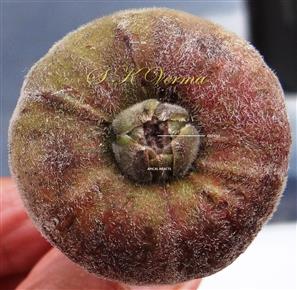
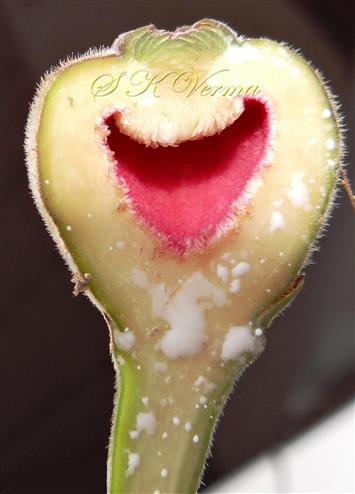



-DSC06421.jpg)
 and Hypanthodia-DSC06419.jpg)
-DSC06568.jpg)







